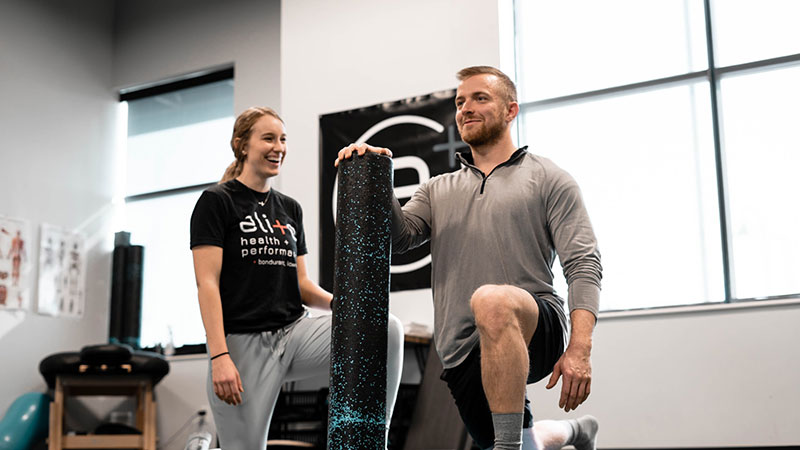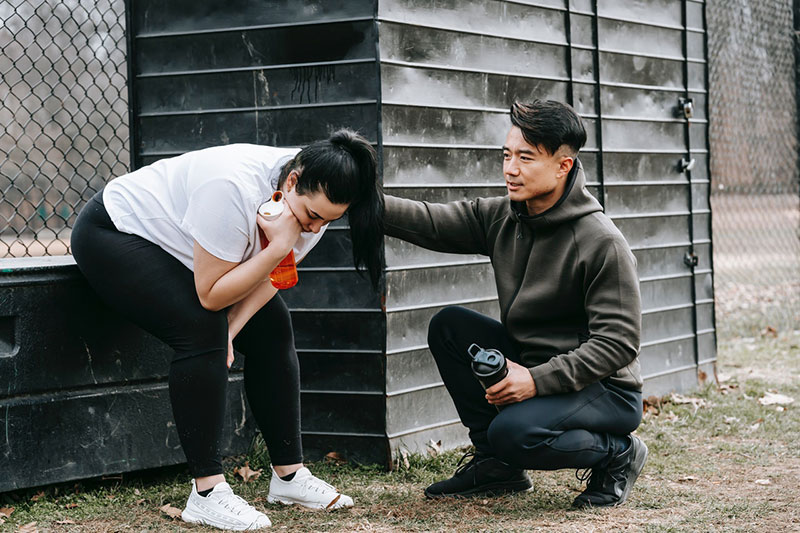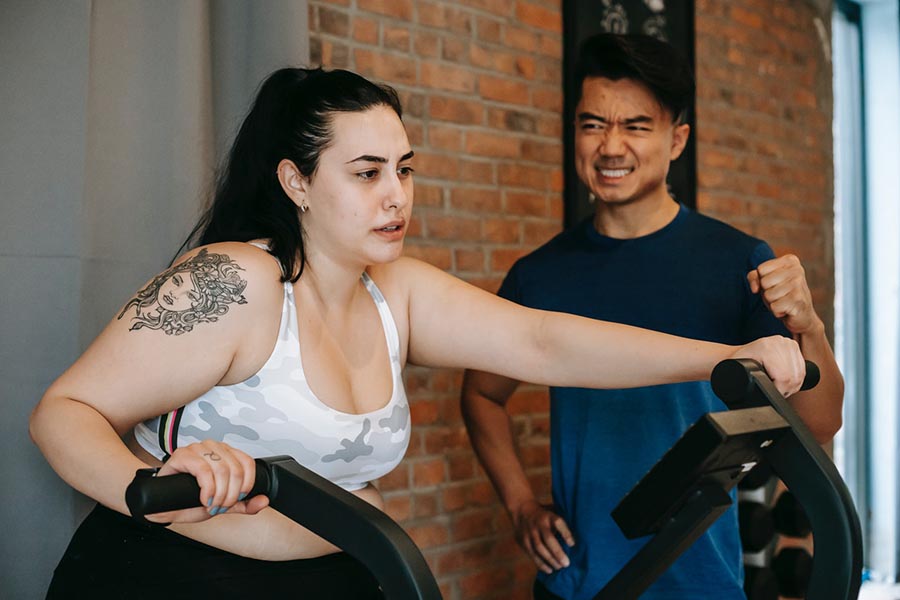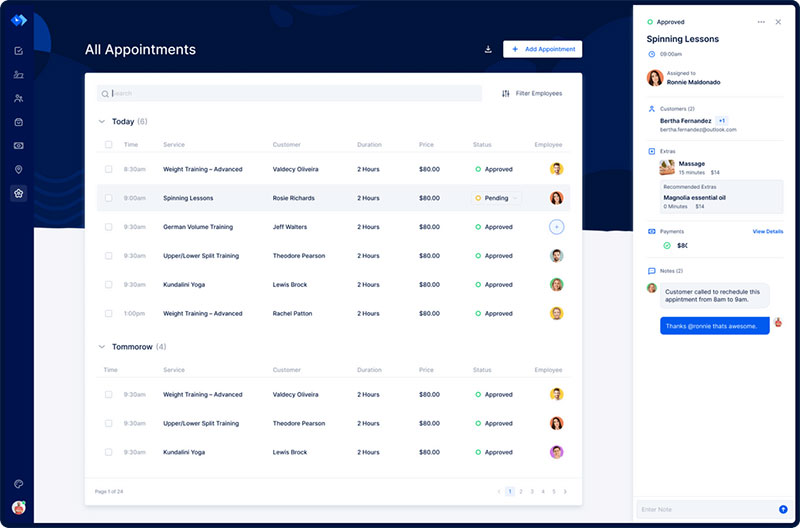The weight-loss journey of an obese person can be an emotional and difficult one. In general, those who are obese struggle with eating too much and exercising too little. When they reach out to a personal trainer for help they need much encouragement.
Training obese clients can present several unique challenges but it can also be very rewarding. Obesity often leads to serious health problems. A personal trainer can help an obese or overweight client reduce the risk of health problems and experience significant benefits.
However, morbidly obese clients cannot perform the same exercises as other people. Personal trainers need to adjust their workout plans and adapt to the abilities of the client. They need to take into consideration the physical limitations of the client. They also need to be realistic and provide a plan that puts the client on the path to long-term success.
What can a personal trainer do to support an obese client? What type of exercises should they do with them? The following tips on personal training for obese clients can guide a personal trainer through this challenging process.
How to Start
Attitude:

The most important thing a personal trainer needs to do to train an obese client is to build a rapport with them. They need to display a kind and compassionate attitude. The client needs to feel supported and that they can trust the trainer.
Forethought:
Fitness professionals need to understand that clients who are obese require much thought and care. Trainers need to be aware of exercises that could injure the client and avoid them. They also need to keep in mind that an obese client cannot perform the same activities that other clients can. They need to modify the exercises according to the limitations of the client.
Customize:
Personal training for obese clients should be personalized. This is true for every client of a personal trainer but especially for those who are overweight.
The best way for a personal trainer to help an obese client lose weight is to create a customized workout plan. A personal trainer should ask the client about his background such as health issues, injuries, hereditary factors, etc. Then they can create an effective workout program that manages health risks.
Encourage the Client

Discouragement is often the reason why clients quit exercising. Exercising and losing weight takes a complete lifestyle change. Establishing and maintaining a new lifestyle takes a lot of effort and work. If the client gets discouraged, they will struggle to maintain their new habits and lifestyle.
Fitness professionals are responsible for the encouragement of their clients. Every client, and even more so obese ones, need encouragement, commendation, and a supportive hand. The relationship a personal trainer develops with a client might be the only thing that prevents them from giving up.
What are some ways to encourage clients?:
Build trust:
One way to encourage clients is to build trust with them. They need to know that the exercises you assign them are not going to injure them. They also need to know that you care about them personally and want them to experience the benefits of having a healthy body.
Set small goals:
Another way is to set small and reachable goals. Soon the client will accomplish those goals and their confidence will begin to rise. They will enjoy exercising more and more as their confidence grows.
Show enthusiasm:
Fitness professionals are enthusiastic about exercise and physical fitness. Obese and overweight clients, in general, do not enjoy exercising and are not excited about it. Enthusiasm is contagious so show your enthusiasm and it will rub off on your clients.
Cheer them on:
As a client does the exercises make sure to cheer them on. Tell them to keep going and not to give up. Perform the exercises with them so that they do not feel alone. When they are done with the determined number of exercises tell them that they did a great job. Utilize emails, texts, and social media to cheer clients on.
Commend them:
Commendation goes a long way in encouraging clients to continue progressing. After they complete a set of exercises tell them how great they did. Tell them what attributes and qualities they possess that will make their success a sure thing.
Be honest:
Do not shy away from telling obese and overweight clients the truth. They need to be aware of the health risks posed by their weight. Do not promise quick and painless success. Explain that losing weight takes time and a great deal of effort. Also, if you see them exercising improperly or making poor decisions make sure to correct them. Clients will appreciate your honesty.
Be patient:
Losing weight is a long journey that takes several years. Clients might experience many setbacks. Stay patient with clients especially when they are having a bad day. If you are patient with them they will be patient with themselves.
Do not be overly strict:
Imposing inflexible restrictions can discourage clients. Make sure they understand how often they should exercise and how they need to change their diet. But do not impose unyielding and unreasonable restrictions. Let clients have some freedom to enjoy themselves every once in a while.
Avoid Embarrassing Situations for an Obese or Overweight Client

Many people feel self-conscious about their weight and this feeling is heightened in a gym. Considerate fitness professionals think of ways to make the situation less embarrassing for clients.
Here are some examples:
- Make sure to know the weight limits of any exercise machines you use. Do not ask an obese client to use a machine that cannot support his weight. Nothing would be more humiliating for the client than breaking an exercise machine. If a client is too heavy for some exercise equipment, modify the exercises. Focus on using other equipment such as resistance bands, weights, etc.
- If possible, exercise outside. The gym setting might be unnerving for some clients since everyone there can see them. If it is possible to do cardio workouts outside in a more private setting then opt for that.
- Do not have a workout circuit that makes obese or overweight clients repeatedly get up and down from the floor. It is likely that clients who are overweight will have joint problems or pain. Having them get up and down from the floor over and over will cause pain and could embarrass the client. Substitute floor exercises with standing or sitting modifications. Or group floor exercises together so that they can do several at one time and only have to get up from the floor once.
Get more bookings with the right tool for the job
Staying organized has never been easier.
You can now manage your business and grow your brand with a single, powerful software that keeps all of your appointments in line, your clients organized and your business booming.
Trafft is the perfect personal trainer software for business owners who need to streamline their booking experience both for their staff and their clients.
Trafft handles everything for you, even sending automated email or SMS reminders to your clients. No-shows? Not anymore!
The Trafft booking software adapts to different industries for a blissful online booking experience and employee management.
Want to know more? Check out Trafft's awesome features to see what you are missing.
Personal Training for Obese Clients: Exercise Examples
Consider factors such as age, weight, health, etc when assigning exercises to different clients. The following suggestions are useful for obese and overweight clients:
Breathing Exercises
Breathing exercises are a valuable component of fitness. Maximizing a client's breathing brings rejuvenating benefits to the mind and body. Studies show that breathing exercises decrease anxiety and improve sleep quality. Reducing stress and getting a good night's sleep are known to help people advance in their search for wellness.
Breathing exercises provide another benefit. Breathing properly while exercising is vital. Breathing in sufficient oxygen helps build muscle. Use breathing exercises to teach clients how to breathe while exercising.
Low Impact Cardio
Some more workout ideas for obese people include low-impact cardio exercises. Overweight people do not need to do high-intensity cardio. Avoid jumping, running, and plyometrics. The goal should be to get them moving, keep them moving, raise their heart rate, and avoid injury.
Some low-impact cardio exercises include:
- Walking
- Hiking
- Stationary cycling
- Rowing
- Swimming
- Aerobic exercises
- Jumping jack arm movements with no jumping
- Marching in place instead of high knees
- Walking lunges
Start an obese client off on the treadmill if possible and encourage them to walk as much as they can. Assign them to walk for at least 30 minutes every day. Also, encourage them to take the stairs instead of elevators or escalators. Make sure that when they use the treadmill or elliptical machine they are not supporting their body weight on the handrails.
Modified Exercises to Lose Weight
Fitness professionals teach beginners, and especially heavier clients, modified versions of common exercises. Modified versions are within the capabilities of the client but still help build muscle and lose weight. They also help avoid injury and put less stress on the client's joints.
Some examples are:
- Modified push-ups
- Leg lifts from a sitting position
- Modified squats
Summary and More Advice to Train Obese and Overweight Clients
- Build a rapport with the client
- Prepare personalized workouts
- Avoid exercises that can cause injury
- Remember that obese people are more susceptible to injury, dehydration, and fatigue
- Make sure your equipment is suitable for heavier clients
- Encourage clients with enthusiasm and commendation
- Be conscious of self-esteem and body image issues
- Use exercises that make the client support their body weight
- Avoid high impact exercises
- Avoid lateral exercises
- Start with low-intensity exercises and increase the duration as the client progresses
- Be aware of supine exercises that could compress the chest
FAQs about personal training for obese clients
1. Is personal training appropriate for obese clients?
Because it provides individualized attention and a customized fitness and nutrition plan that can help clients lose weight safely and sustainably, personal training can be quite successful for obese customers. Finding a skilled and experienced personal trainer who is aware of the particular difficulties involved in working with obese clients is crucial.
2. How can a personal trainer help an obese client achieve their weight loss goals?
By creating a personalized fitness and nutrition plan that is catered to their particular requirements and abilities, a personal trainer can assist obese clients in reaching their weight loss goals. Exercises that can be used to achieve this include a mix of cardio, strength training, and flexibility drills, as well as a well-balanced diet that encourages healthy weight loss.
3. What types of exercises should an obese client focus on during personal training sessions?
Obesity individuals should concentrate on low-impact workouts that reduce the possibility of damage, such as walking, swimming, cycling, or utilizing an elliptical machine. They should also include strength training activities to increase muscle mass and speed up metabolism, both of which can help them lose weight.
4. What are some common mistakes to avoid when training obese clients?
While training obese clients, frequent pitfalls to avoid include pushing them too hard too soon, failing to consider their particular requirements and limitations, and failing to offer enough support and encouragement during their weight loss journey.
5. How can a personal trainer create a safe and effective workout plan for an obese client?
A personal trainer should first determine the fitness level and restrictions of an obese client before designing a training program that gradually rises in intensity and complexity over time. They should also include a variety of fun activities that work out the client's diverse muscle groups.
6. What role does nutrition play in personal training for obese clients?
Since a balanced, healthy diet is necessary for long-term weight management, nutrition is an important component of personal training for obese individuals. An individual trainer can collaborate with their client to create a meal plan that is nutrient-dense, high in whole foods, low in processed foods, and supports weight loss objectives.
7. How long should an obese client work with a personal trainer to see significant results?
The client's unique goals, beginning weight, and other factors will determine how long it takes to achieve noticeable results. Nonetheless, to see significant results, it is generally advised that obese clients engage with a personal trainer for at least three months.
8. How can a personal trainer help an obese client stay motivated throughout their weight loss journey?
An obese client's motivation can be maintained throughout their weight loss journey with the help of a personal trainer by setting reasonable and doable goals, receiving regular feedback and encouragement, and receiving ongoing support and accountability. They can also help their clients stay interested by introducing engaging and enjoyable workouts into their fitness program.
9. Are there any specific certifications or qualifications that personal trainers should have to work with obese clients?
Personal trainers should have a firm grasp of exercise science, anatomy, and physiology in addition to experience dealing with clients of all fitness levels and abilities, even if there are no particular credentials or qualifications needed to work with obese clients.
10. What should an obese client look for in a personal trainer to ensure they receive the best possible care and support?
A fat customer should seek out a personal trainer who is informed, skilled, and empathetic and who spends the time to comprehend their particular needs and objectives. To assist people to stay on track with their weight reduction quest, they should also look for a trainer who is understanding and encouraging as well as who offers continuing guidance and accountability.
Ending thoughts on personal training for obese clients
Training obese or overweight clients can be rewarding and joyful as you see their lives transform. However, it can also present a few unique challenges.
One challenge is to modify the exercises. Remember that exercise and weight loss principles are the same for everyone. The best weight loss results happen when a client uses more calories than they take in and do cardio and strength training exercises. Even if obese people cannot do high-intensity workouts, there are many exercises that they can do. The most important thing is to get them moving on their path of weight loss.
The biggest challenge personal trainers face is keeping clients motivated. Often clients struggle to change their habits and stay motivated. Losing weight takes time and much effort. Plus, a weight-loss journey is not a straight path; some days are better than others. Clients get discouraged when they experience setbacks. Fitness professionals need to show enthusiasm, give commendation, and avoid "shaming" comments.
With a little forethought and a positive attitude, it is possible to help obese and overweight clients change their lives. Use the above personal training for obese clients tips to help you be successful.
If you enjoyed reading this article about personal training for obese clients, you should also check out this one on how to start an online personal training business.
We also wrote about similar topics like:
- Being A Personal Trainer for Seniors
- The Best Personal Trainer Client Tracking Options to Use
- How To Sell Personal Training To Potential Clients







